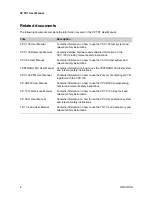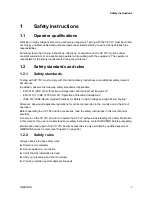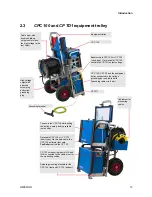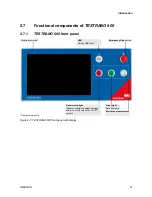
OMICRON
9
Safety instructions
Before performing tests using high voltage, observe the following instructions:
► Do not use the test equipment without a good connection to substation ground.
► Do not insert objects (for example screwdrivers, etc.) into any input/output socket.
► Do not operate the
CP TD1
under ambient conditions that exceed the temperature and humidity limits
listed in 12.2 "Environmental Conditions" on page 109.
► Make sure to position the test equipment on dry, solid ground.
► Do not operate the
CP TD1
in the presence of explosives, gas or vapors.
► Opening the
CP TD1
invalidates all warranty claims.
► Do not use an extension cable on a cable reel to prevent an overheating of the cord; run out the
extension cord.
► If the
CP TD1
does not seem to function properly, do not use it anymore. Please call the OMICRON
technical support.
1.4
Handling cables
► Always turn off the
CP TD1
completely before you connect or disconnect any cable (disconnect the
CPC 100
from mains or press its Emergency Stop button).
► The high-voltage cable must always be well attached and tightly connected to both the
CP TD1
and
the test object. A loose or even falling off connector at the test object carrying high-voltage is life-
hazardous. Make sure the connectors are clean and dry before connecting.
At the
CP TD1
, press the high-voltage cable’s plug to the connector tightly and turn the screw cap
until you feel a mechanical stop. If you notice a rough-running of the screw-cap, clean the screw
thread and use a lubricant (Vaseline recommended).
At the test object, insert the high-voltage cables’ plugs carefully until you feel a "click" position. Now
they are locked. Confirm this by trying to pull them out. This should not be possible now.
Note:
Tighten the plugs manually. Do not use any tools for that because that can damage the plugs
or connectors.
Insert the yellow banana plug (the high-voltage cable’s grounding) into the respective plug socket.
► Do not connect any cable to the test object without a visible grounding of the test object.
► The high-voltage cable is double-shielded and therefore safe. However, the last 50cm (20 inch) of
this cable have no shield. Therefore, during a test consider this cable a life wire and due to the high-
voltage life-hazardous!
► When the
CPC 100
is switched on, consider this part of the cable has to be in the high-voltage area
due to a hazard of electric shock!
► Never remove
any
cables from the
CP TD1
or the test object during a test.
► Keep clear from zones in which high voltages may occur. Set up a barrier or establish similar
adequate means.
► Both low-voltage measuring cables must always be well attached and tightly connected to the
CP TD1
’s measuring inputs IN A and IN B.
Make sure to insert the red and blue marked cables into the corresponding measuring inputs: IN A =
red, IN B = blue.
Tighten the plugs by turning them until you feel a stop.
Note:
Tighten the plugs manually. Do not use any tools for that because that can damage the plugs
or connectors.
► Do not use any other cables than the ones supplied by OMICRON.
Summary of Contents for CP TD1
Page 1: ...CP TD1 User Manual...
Page 70: ...ENU 1035 05 03...










































